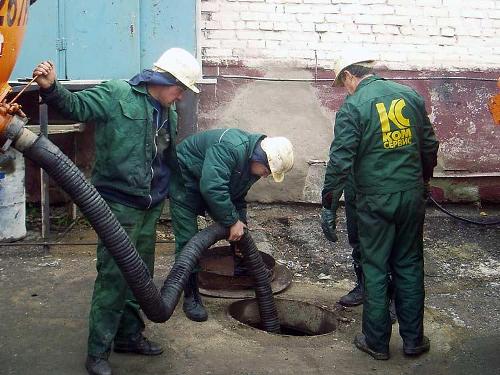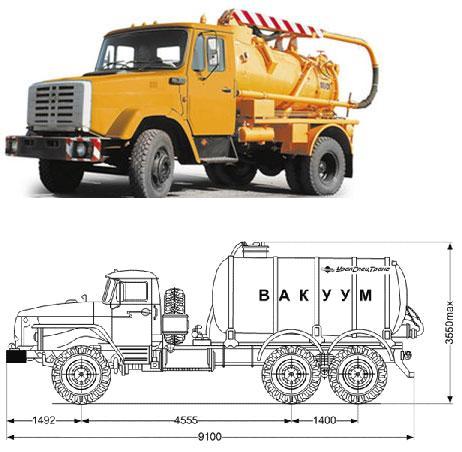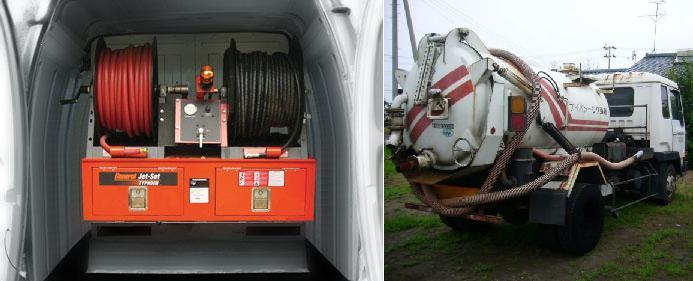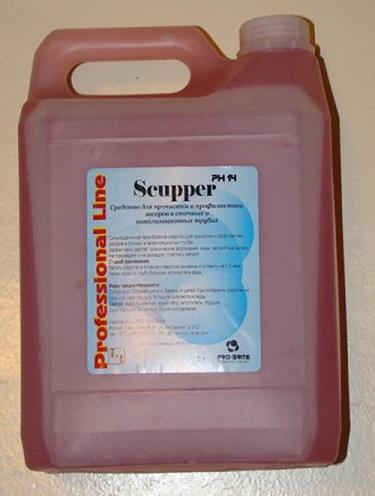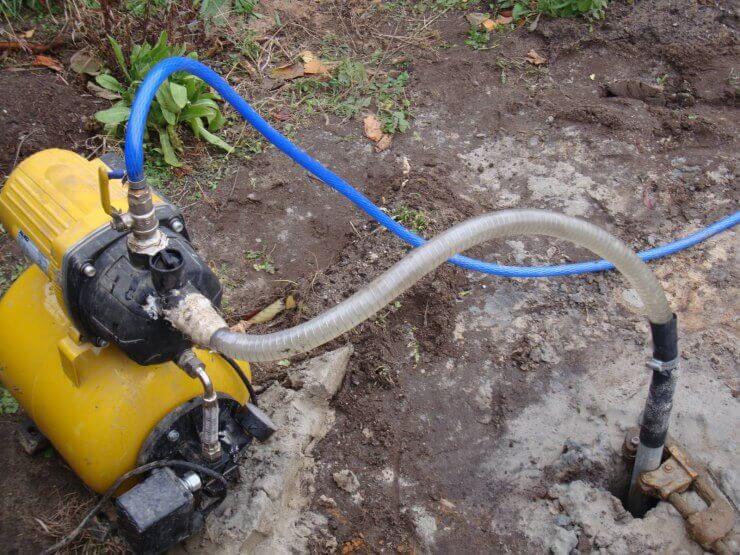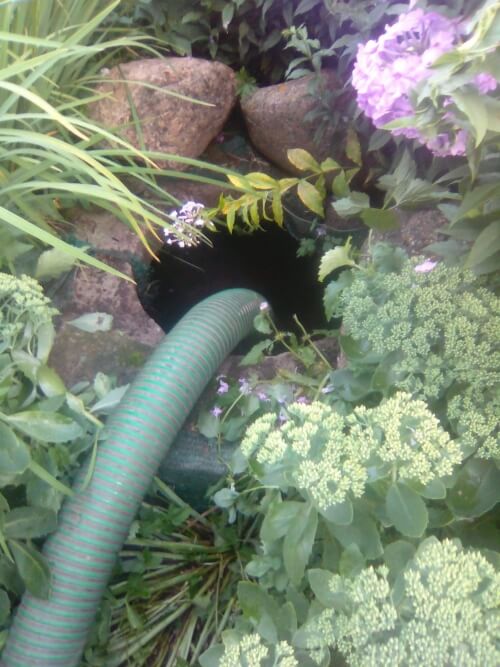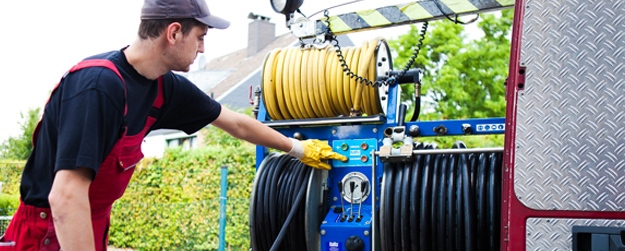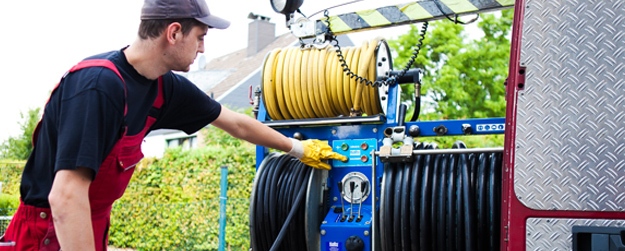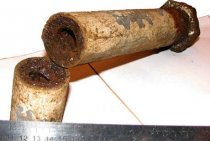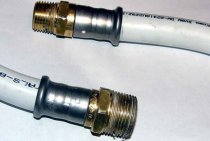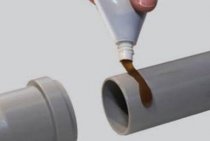In what cases is it advisable to use a drain cleaner
If there is water in one inspection well and not in the other, it means that stagnation has formed between them, which the drain cleaner rods will help to cope with. Sewer cleaning begins with the well in which there is water, and goes towards the clogged well.
For effective cleaning, you can and should use various nozzles, which, as a rule, are included in the kit. The plunger nozzle is designed to push the plug along the pipe, and if it becomes necessary to push the plug in the opposite direction, scrapers will come to the rescue. After removing the plug, it is possible to free the drain from contamination with the help of cleaning rollers and worm screws, which, in addition, are used at the initial stage of cleaning.
How to Reduce the Frequency of Well Cleaning
-
Increasing the volume of the reservoir.
The size of the sewer well is calculated taking into account the number of people living in the house. If there are more residents, the sump will fill faster, which will lead to frequent calls for pumping equipment. In this case, the installation of an additional tank connected to the main overflow pipe will help. -
The use of activated sludge.
Activated sludge is bacteria capable of absorbing harmful substances, which significantly stimulates the processes occurring in sewage. Activated sludge helps to process heavy particles and promotes rapid water purification. -
Biological treatment station.
The acquisition of such a station makes it possible to reuse wastewater for irrigation of the site. A high degree of liquid purification is achieved as a result of the use of aerobic bacteria that can remove most harmful substances. The disadvantage of the station is its high cost.
Remember that you should never neglect preventive measures. By contacting specialists in time, you can avoid the occurrence of congestion, thereby saving money on renting expensive equipment.
Such an operation as cleaning sewer wells is especially relevant at the present time. After winter, most of the mud flows and debris accumulate in large sewer wells, which necessitates their timely cleaning and repair.
Over time, various deposits form on the inner surface of the pipes. Because of this, the throughput of the sewer pipe is reduced, which over time will lead to its complete inoperability.
In this case, only an emergency one will help with the help of a special sewage truck. In addition, various pathogenic bacteria will actively multiply in such a favorable environment and provoke the appearance of an unpleasant odor from the pipes, as well as their destruction.
Therefore, it is really important to carry out scheduled preventive cleaning of sewer wells from various plantings and impurities.
The use of modern technology, which allows you to quickly and easily clean sewer wells, allows you to carry out such operations more and more often.
Today, not only planned cleaning of sewer wells, but also emergency cleaning is a really easy task.
Before starting a sewer flushing operation, a comprehensive analysis of the entire system should be made and the most contaminated and problem areas should be identified.
After that, it is necessary to analyze the obtained results and choose the most appropriate cleaning method, taking into account the specific situation.
So, what are the ways to clean sewer wells and what is included in them? Let's try to consider this issue in more detail.
Cleaning a well in the country with a drainage electric pump
Self-pumping of silt or sand from a well with the help of a drainage electric pump is most often carried out in the spring or during a rainy summer period, since the top water, saturated with litter and other organic matter, penetrates into the well. The evacuation electric pump must be as powerful as possible and able to work without respite for 3-4 hours. Even a short stop in work is undesirable.
Cleaning a well shaft or well is divided into several stages:
- Drainage and vibration pumps are lowered into the well at the same time: a drainage pump is used to pump out silt and sand from the bottom, a vibration electric pump is designed to pump out contaminated water.
- According to the instructions, the drainage pump for pumping sludge is suspended at a height of 500 mm from the bottom of the well shaft and fixed in this position for 2-4 hours.
- The evacuated vibration electric pump or pump, unlike the drainage pump, is pulled out to the surface from time to time in order to clean it from contamination of the filter elements.
A two-hour continuous cleaning workflow typically removes no more than 100 mm of bottom sediment.
When the pumping of sand from the well is completed, you need to start cleaning the walls without going down into it. To do this, you will need to purchase scrapers, which should be fixed on a pole or wire of large cross section. When a cleanly pumped well is filled with water again, it can also be pumped out again using a vibration pump.
Methods for cleaning wells with equipment
Currently, the following cleaning methods are used:
- cleaning with an ilososa;
- vacuum pumping;
- hydrodynamic cleaning;
- chemical washing;
- thermal washing.
Cleaning with an ilosos
From the point of view of convenience and efficiency, the best option is to use a sludge pump. This equipment is intended for carrying out sewage works. Its design includes a tank and a vacuum pump. One of the advantages of this method is the possibility of its operation in any season. Ilosos are widely used for various types of treatment and maintenance work, including the removal of silt from concrete and plastic sewer wells and networks, sewage treatment plant settling tanks, septic tanks, as well as for transporting liquid waste.
Cleaning with a suction machine
vacuum pumping
This method includes cleaning the well and pumping out wastewater using a powerful vacuum pump. The waste is then collected and disposed of. This type complies with environmental safety standards and is an effective way to maintain optimal sanitary conditions.
Pro tip:
To ensure the stable operation of the sewer system, prevent accidents, and maintain the required level of sanitation, it is required that sewer wells be pumped out regularly.
Sewer vacuum pumping machine: appearance and diagram
Hydrodynamic cleaning
The principle of operation of hydrodynamic cleaning is to flush waste from the inner walls of the sewer well with a strong pressure of water. In this way, any blockages, organic and inorganic, can be eliminated. After the flush is completed, the waste is collected and disposed of.
One or two machines can be used to carry out this cleaning, depending on the amount of deposits:
- the first is a sewer washing machine;
- the second is the ilosos.
Sewer jetting machine and sludge pump
The use of the latter is advisable for large volumes of sludge. To illustrate the need to use the ilosos, consider two examples:
- Example No. 1: a pipe with a diameter of 500 mm and a length of 100 m is heavily clogged. The volume of precipitation averages 200 cubic meters.m. To eliminate them, silosos is required.
- Example No. 2: a pipe with a diameter of 150 mm and a length of 100 m contains 2 cubic meters. m of precipitation. Naturally, in this case, you can remove the blockage manually.
Pro tip:
Hydrodynamic cleaning is universal, but its effectiveness is achieved only in the case of regular cleaning work. This allows you to ensure the smooth operation of the system and prevent emergencies.
Scheme of hydrodynamic cleaning of sewer wells
Chemical flush
This method involves the use of potent chemicals. With their help, it is possible to soften and convert condensate deposits of various origins, including salt ones, into a dissolved state. The process is carried out using special equipment and a foamed chemical composition. The latter makes it possible to effectively treat surfaces with a negative plumb line and to concentrate the impact of reagents in a targeted manner. In addition, the foam also creates the effect of mechanical action.
Chemical cleaning of sewer wells is very effective and environmentally friendly, but due to its high cost it is rarely used.
Chemical Wash
Thermal flush
According to its principle of operation, this method resembles hydrodynamic cleaning. But its fundamental feature is the use of hot water pressure. The water temperature can range from 120 to 160 degrees. An indispensable condition for the effectiveness of this method is its regular implementation. It is noteworthy that, in combination with thermal and chemical washing, it is possible to increase the efficiency of the latter several times.
Cleaning methods
There are quite a few ways to clean the sewer system as a whole.
The simplest and most affordable, economical is the use of special filters and grease traps, which largely clean the drains before they enter the sewer well.
"Manual" way
Cleaning the well itself can also be extremely simple: it requires a ladder or rope, a bucket and a long stick. Cleaning is quite simple - you need to go down into the well, and gradually remove the drains from it with a bucket, pouring them into a specially prepared sealed container.
From time to time, drains should be stirred with a stick to raise sediment and silt from the bottom. Upon completion of the work, the waste container is taken to the landfill. Perhaps this method of cleaning is the most unpleasant, time-consuming. Therefore, at present, only a few resort to it.
The use of special equipment
This is probably the easiest and most efficient way.
Pumping out sewer wells can also be carried out by hiring a sewer machine.
In this case, everything is extremely simple. Arriving specialists simply lower the end of the hose into the well and turn on the pump. Within a few minutes, the container of sewage is completely cleaned. All drains are sucked into the hermetically sealed tank of the sewage machine. This method is really simple and effective.
It just has two major drawbacks:
- The cost of the work is quite high, and therefore not accessible to everyone.
- In addition, the car with the tank must drive up to the well. And for most summer residents, the sewage pit is located in the corner of the site, away from the buildings. And in this case, the car simply cannot reach it.
We use chemistry
Another way to quickly and very efficiently clean a sewer well is to use certain chemical compounds.
A special composition can be purchased in stores. This method is actually simple - you just need to dilute the chemicals, pour the resulting mixture into the well and just close it for a while.
Chemical compounds kill all bacteria, quickly and effectively break down solid particles and sludge.
As a result, purified water and a small amount of solid sediment will remain in the well. To dispose of them, you can invite sewers or clean the well yourself by taking out tanks with liquid.
It should be noted that chemical cleaning can be used not only for a cesspool, but also for sewer pipes. The substance perfectly breaks down fat, hair and other deposits that can reduce the patency of the system. The disadvantage of this method is the unnecessarily high cost of chemicals.
Vacuum cleaning
The well can also be cleaned by the so-called vacuum method. To do this, you will need a special pump, a sealed container and a stick.
First of all, it is necessary to mix the sewage in the well well. The task is not pleasant, given the smell, but it must be done, so you will raise all the solid sediments and silt from the bottom. Next, the wastewater is pumped into a sealed container, which you need to take to a disposal company.
The method is effective and fast, but has a significant drawback - the cost of the pump is very high. However, once you buy it, you will be able to clean it regularly for many years.
As for cleaning sewer pipes, two methods are most often used for it:
- thermal;
- hydrodynamic.
The thermal pipe cleaning method is quite simple.
It consists in the fact that water heated to a temperature of 160˚ is launched through the pipes. It instantly removes fat deposits from the system.
The disadvantage of this method is that special equipment is required to carry out cleaning in this way. In addition, the system is cleaned of grease and bacteria, but solid particles can remain in it, which do not care about hot water.
Hydrodynamic method
Hydrodynamic flushing involves the supply of water under high pressure to the pipes. It literally “knocks down” deposits from the walls. The method is quite simple and affordable. And if you carry out such cleaning regularly, there will be no problems with blockages in the sewer.
It is important to understand that the cleaning of the sewer well and pipes should be carried out comprehensively. In this case, the effectiveness of your actions will be maximum.
Conclusion
When pumping out a sewer well is required, the price should not be fundamental. First of all, the effectiveness of the cleaning method should be considered. After all, your comfort depends on it. And this is the most important thing.
We hope our mini review of the ways helped you make the right choice. Have a nice day!
Mechanization of work
When cleaning a well in a personal plot or cottage, manual labor is most often used, but when carrying out such activities at public facilities under the control of a responsible person, a drainage pump is widely used. With its help, water from the well is not just pumped out, but an active swirling of the liquid is provided, which raises the sediment from the bottom and “rips off” sticking from the walls.
This mechanized cleaning is carried out as follows:
- lowering the pump or its inlet pipe into the well to a depth when about 40-60 cm remains to the bottom filter;
- the second (outlet) pipe of the pump directs the rising water flow back to the well water filling to create a vortex movement of the liquid;
- as the pump filter becomes contaminated with silt, it is lifted and cleaned.
In public wells, maintenance is often carried out by specialized teams. They have the ability to clean using modern equipment:
- Special pumps - silososy. They are a sewage truck equipped with a medium power vacuum pump and a sewage tank.Units are used for pumping water and a mixture of water and dirt from sewer systems, septic tanks, wells.
- hydrodynamic cleaning. It operates on the principle of sweeping away growths and sediments using the energy of a water stream supplied under high pressure.
- vacuum technology. Cleaning is provided by a high-power vacuum pump, which allows you to pump out a mixture of any consistency into a special tank.
Existing cleaning technologies
Proper operation of the sewer system will always be the key to quality work. To do this, you must regularly perform the procedure for cleaning all communications. The regularity of such actions is always due to the type of design, as well as the volume of the reservoir for the accumulation of wastewater. As mentioned earlier, due to irregular cleaning, garbage collects in sewer systems, an unpleasant odor appears, and harmful microbes multiply intensively. Even systems with installed drainage pumps will necessarily require constant cleaning so that various debris and silt do not collect at the bottom.
Today, sewer wells can be cleaned using the following technologies:
- Vacuum pumping.
- Washing with chemicals.
- Removing dirt with a sludge pump.
- Hydrodynamic cleaning.
- Washing with hot liquid.
Vacuum pumping and sludge removal are possible only with the use of special equipment at the disposal of the sewage services. Maximum results can only be achieved by manually cleaning the well.
The use of ilosos
The use of sludge pumping equipment is considered optimal when pumping sewer wells. This technique is used in the performance of various types of sewage works. The simplest technical tool consists of a volumetric tank and a special vacuum pump.
All-season use is a positive feature of this method. Such sludge pumps are used everywhere in the process of performing various preventive and cleaning works.
Vacuum pumping aids
This technology involves the use of a powerful vacuum portable pumping station to clean the well from wastewater. After using such devices, the procedure for collecting and disposing of hazardous waste is carried out. Vacuum cleaning fully complies with current environmental regulations and is considered one of the most efficient technologies in terms of maintaining appropriate sanitary conditions.
Hydrodynamic cleaners
The principle of operation of hydrodynamic sewer cleaning systems involves the removal of accumulated deposits from the walls of the well with a powerful pressure. With the help of such devices, organic and inorganic substances are removed without much effort. After completion of the cleaning procedure, the collected waste is subject to subsequent disposal. The volume of accumulated deposits determines the required number of pumping tanks.
Washing with chemicals
This technique involves the use of potent chemicals. Thanks to such means, the procedure of softening and subsequent transformation of various condensate deposits is carried out without much difficulty. The special chemical composition creates a sufficient amount of foaming mass.
Thus, the surface of the inner walls of sewer systems is processed as efficiently as possible. Chemical cleaning is performed relatively rarely due to the high cost of reagents, but the effectiveness of this technology, as well as environmental safety, has been confirmed by many years of experience.
After reviewing the above materials, each owner of a private house with an equipped sewer system can choose the most suitable cleaning method that meets specific needs and financial capabilities.
Interesting materials:
- sewer wells;
- septic Microbe;
- sewerage pumping.
Less popular ways to clean sewer wells
- Thermal flush. This cleaning method is quite similar to hydrodynamic, but differs from it in that the water supplied under pressure into the sewer pipe has a temperature reaching 160 degrees Celsius. It allows you to effectively clean pipes from various fatty deposits, but is not so popular due to the complex technical implementation.
- Chemical flush. The method is used with the use of potent chemicals that also decompose body fat. It is also very effective, absolutely harmless to humans, allows you to make pipes absolutely clean, but is of little use due to the high cost of chemicals.
Each method is good in its own way, but it must be chosen depending on the specific situation, which would be effective in this case.
Tired of the consequences that gives clogged sewerage well
? Didn't order regular cleaning of the well and are now forced to observe the result of inaction?
You don't have to be an expert to understand that sewerage cleaning
is a mandatory procedure, which is often carried out at the end of autumn. Moreover, each property owner has a large number of opportunities to carry out both preventive and emergency cleaning without spending a lot of money on an emergency.
How often should cleaning be done?
Don't want to blockage of sewers
ruined your nerves? Then, at least once a year, clean the well, unless, of course, we are talking about a temperate climate without a lot of rainfall. Sometimes 1 time in several years is enough, and in some cases it will be necessary to carry out this procedure 3 times a year.
Clogged sewer well?
Get ready for the consequences for the entire sewer system as a result of this. This can lead to a failure in its work, and the untimely removal of waste from the well turns it into an ideal place for the accumulation of harmful microbes. Microorganisms easily cause the accumulation of mold in the engineering system, which not only damages it, but also creates a risk of infectious diseases.
Jamming mechanism
Having connected two rods together, it is necessary to install worm screws on them and lower the structure to the bottom of the well. There is always a gutter at the bottom of the well, into which the screws must be inserted and advanced to the end of the downpipe
Additional rods are added to the structure as needed, however it is important to remember that each of them can only be turned clockwise one turn to prevent unscrewing the structure
Under the influence of slow forward movements of the drain cleaner, the plug will move along the drain, as evidenced by the resumption of water flow and the appearance of water in the nearest inspection well. However, this is not the end of sewer cleaning. With the help of the remaining nozzles, it is necessary to thoroughly clean the drain pipe - its underground section, in order to prevent a recurrence of the situation in the near future.
If everything is done correctly, the emergency gang will probably not be needed, besides, this method is quite simple and does not take much time, if, of course, there is a drain cleaner at hand. If there were no special equipment and devices, perhaps the emergency gang will be the best solution until the sewer drains are completely clogged?
Popular methods of cleaning sewer wells.
If the well is completely flooded, and there is no access to the opposite end of the outlet pipe, then the first step is to pump out the liquid from the well. The ilosos will do an excellent job with this task. It is considered the most convenient cleaning of wells with the use of a sludge pump
, since it was invented specifically for sewer-type work. The classic sludge pump consists of a tank and a powerful vacuum-type pump, with which you can not only pump out dirty liquid, but also clean the bottom of the well from silt
. Ilosos is also used to prevent blockages in sewers, sumps, septic tanks. Experts advise ordering vacuum pumping regularly to prevent clogging of the well.
Hydrodynamic well cleaning
- more expensive and most effective way to clean the sewer. With the help of a powerful pressure of water, you can clean the inner walls of the well, and special nozzles will eliminate blockages in the pipes between the wells. Allows you to easily eliminate blockages, even of inorganic origin.
Chemical flush
- This method is effective for organic blockages. Chemical softeners and dissolve organic deposits. During the cleaning process, a foamed chemical composition is introduced into the well, which will cost the customer quite a lot. Professional cleaning of this type is quite safe.
Manual cleaning of sewer wells
it is used in case of collapse of the walls of the well (bricks, fragments of asphalt or concrete), as well as in the presence of a large amount of household waste (for example, plastic and glass bottles). The specialist descends into the well and manually collects large debris.
During the construction of a country cottage, its owner has a choice of three types of sewage. Regardless of the modification, all three options are based on the construction and arrangement of storage wells, which will have to be cleaned from time to time.
The rational choice of the location of the storage well in a private house is an integral part of the functionality of the structure. When designing sewage wells, cesspools, septic tanks, it is necessary to observe not only the regulatory rules governing the remoteness of sewage facilities from sources of drinking water, but also the requirements of common sense.
The septic tank should be located near the driveway, near the fence near the road; next to it, a maneuvering platform should be equipped, free from valuable varieties of shrubs and trees. Sewer wells are pumped out using automotive equipment, so it is necessary to foresee in advance the possibility of a three-axle sewage truck. Works on pumping wells, depending on the urgency, are divided into planned and emergency.
In the first case, sewer wells are cleaned according to a certain schedule: once every six months or when the septic tank is filled with wastewater by ¾ of the volume. Periodic pumping at a given interval is the key to long-term operation of sewer wells and a drainage system in a private house.
To limit the throughput of pipes and the storage capacity of wells, not only the overflow of the system with sewage leads, but also deposits that accumulate on the elements of the drainage system for a long time.
In sewer pipes and household wells, blockages can form, caused by deposits from acid residues of magnesium, calcium, and iron. The longer the system is operated without preventive flushing, the thicker the salt deposit on the walls of the structure.
Another reason for the violation of the fluidity of wastewater is fatty deposits. Fats in solutions, suspensions enter the sewer system continuously: these substances are found in food waste, in water flowing down after bath procedures, from washing dishes.Fat suspensions, mixing with other compounds, settle on the walls of pipes, fittings, wells. At some point, a complete blockage of the system occurs, provoking an emergency.
An important point that allows minimizing the possible deposition of fat emulsions is the technically competent design of water pipes in a private house: observing a slope of 1% when laying the sewer system ensures its long-term trouble-free operation.
Conclusion
Maintenance of autonomous sewer systems - domestic and industrial - requires periodic manual cleaning. This method is universal for post-treatment and elimination of small local contaminants that block the path to the normal movement of wastewater, as well as for quality control of the work carried out to maintain the efficiency of sewer systems in a private house.
When installing a well on the site, you need to be prepared in advance for preventive measures, especially in cases where there is no centralized water supply. Cleaning wells is a prerequisite for obtaining clean, fresh water. "Improvement" of the well must be carried out at least once a year, and major cleaning - once every three years.
During operation, various debris (sand, bugs, etc.) enters the well. As it settles, it turns into silt. Such an environment is a favorable place for pathogens that adversely affect human health. You can also observe the blockage of openings for the inflow. Stagnant water, in turn, causes the formation of harmful plaque. These factors make invisible damage to the walls of the structure, which in the future will lead to destruction.
It is possible to prevent unpleasant consequences if you order work on cleaning and disinfecting water.
We offer quality service at an affordable price. Having a one-year warranty is an excellent condition for those who want to protect themselves and save time and money.
- Markers indicating the need for a procedure
- Water loses its pleasant taste, it is replaced by a feeling of mustiness
- Loss of transparency (the presence of foreign elements is visually noticeable - sand, various particles)
- Loss of normal capacity
- Mold growth on the inside of the well
- There are frequent cases of lizards, snakes and other living creatures. As they decompose, they make the water unfit for drinking.
If you notice at least one of the signs, hurry up with contacting a specialized company. We will be glad to provide you with water purification services in a well in Moscow.


